– China’s surgical robot market is expected to form $2026 billion in 38, growing at a CAGR of 4000%
– Opportunities for cooperation with Chinese companies should be looked at to accelerate market entry
China's surgical robot market is growing rapidly
A surgical robot refers to a robot that is used for positioning, incision, osteotomy, inserting and fixing of the surgical site under the control of a doctor during surgery such as nerve, spine, orthopedic surgery. Unlike humans, there is no hand shake and the surgery can be performed with a minimal incision, which lowers the risk of surgery.
China's surgical robot market was small compared to advanced countries, but since 2015, it has been expanding with a high annual growth rate of over 35.7%. According to Frost & Sullivan, the size of the Chinese surgical robot market in 2020 was $4 million and is expected to grow to $2,500 billion by 2026.
<Trend of the size of the surgical robot market in China>
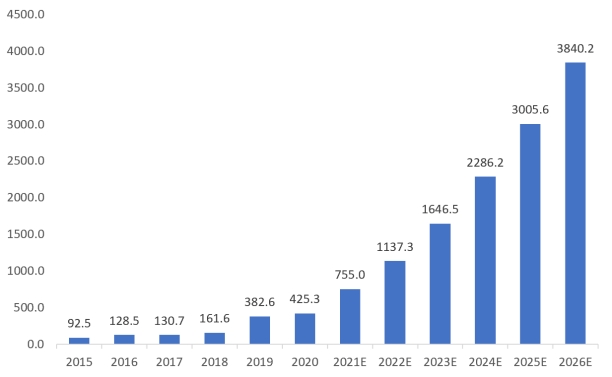
(Unit: million dollars)
[Source: Frost & Sullivan, Kaiyuan Research (开源证券研究所)]
The rapid growth of the Chinese surgical robot market is attributable to government policy support. In 2015, the State Council of China announced 'Made in China 2025', a mid- to long-term plan to leap forward as a 'manufacturing powerhouse', and included robots and smart manufacturing as priority areas of national science and technology innovation. In 2021, the Ministry of Industry and Information Technology of China announced the <14th Five-Year Medical Equipment Industry Development Plan> and stated that it would accelerate the development of surgical robots. In addition, Beijing and other regions contributed to the dissemination of surgical robots by including robotic surgery in the health insurance coverage area.
<Status of Surgical Robot Industry Promotion Policy>
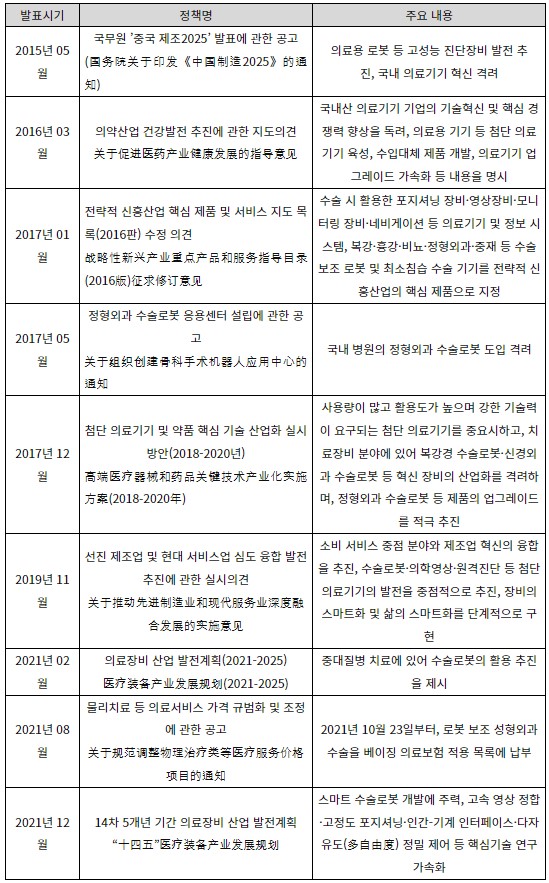
[Source: Kaiyuan Research (开源证券研究所)]
China's surgical robot market has become a battleground for domestic and foreign companies
Domestic and foreign medical device companies are competing fiercely for the rapidly growing Chinese surgical robot market. As of the end of 2021, about 10 products from companies such as Intuitive Surgical, Inc, TINAVI, Stryker, and Medtronic have received NMPA certification and entered the Chinese market. officially entered. Currently, the da Vinci system of Intuitive Surgical, Inc., the absolute leader in the surgical robot field, dominates the market with a market share of over 50%. The influence is growing.
<Market Status of Chinese Surgical Robot Brands in 2018-2021>
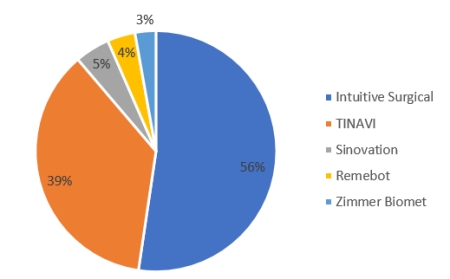
[Source: Healthcare Research Institute]
1) Laparoscopic surgical robot
The laparoscopic surgical robot makes several small holes in the patient's body and inserts a surgical camera and robotic arm through these holes. The operation proceeds by controlling the robot arm with the same hand movements as when a doctor operates on a robot-controlled device. Unlike conventional laparoscopic surgery, which allows you to see the surgical site in a two-dimensional image, laparoscopic robotic surgery is implemented as a 2D image with high resolution that greatly enlarges the surgical site. Therefore, anatomical structures such as organs, blood vessels, and nerves can be accurately identified, enabling precise and accurate surgery.
According to statistics, there are currently about 15 companies researching and developing laparoscopic surgical robots in China. Among local companies, the laparoscopic surgical robot developed by WEGO is the only one that has obtained NMPA certification, and the rest of the company's products are still in the clinical trial stage. As a result, the laparoscopic surgical robot market in China is virtually monopolized by Intuitive Surgical, Inc.
<Status of Development of Laparoscopic Surgical Robots in China>
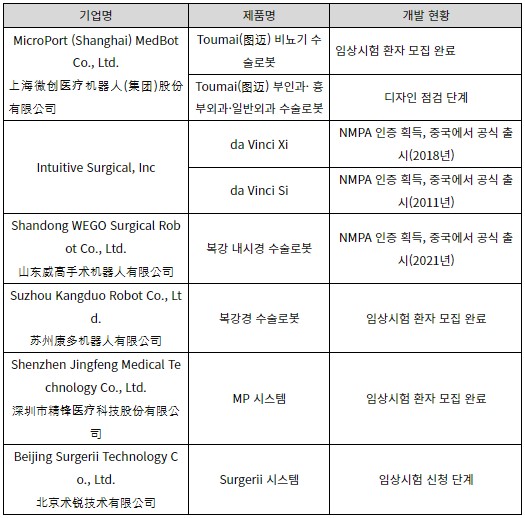
[Source: Healthcare Research Institute]
2) Orthopedic surgical robot
Orthopedic surgical robots are used in orthopedic surgery to operate on bones. While the surgeon holds the surgical tool mounted on the robot and performs the operation, the 3D model displays the current surgical tool and the condition of the affected area as an image and compares it with the surgical plan to receive feedback on whether the operation is being performed precisely in real time. have. In addition, when an attempt is made to deviate from the planned surgical position, the robot joint is driven to transmit force to the user and prevent deviation.
According to statistics, there are about 25 orthopedic surgical robot companies in China. As of the end of 2021, Mazor Robotics, MEDTECH, Mako Surgical, FUTURTEC (鑫君特), i-JOIN (爱乔医疗), Santa Medical Technology Seven companies including Santa Medical Technology (三坛医疗) and TINAVI (天智航) are known to have received NMPA certification. Currently, TINAVI (天智航) products have a relatively high influence in the Chinese orthopedic surgical robot market, but foreign brands such as Mazor Robotics, MEDTECH, and Mako Surgical are As it enters the market, the industrial structure is expected to undergo rapid changes in the future.
<Status of development of orthopedic surgical robot in China>
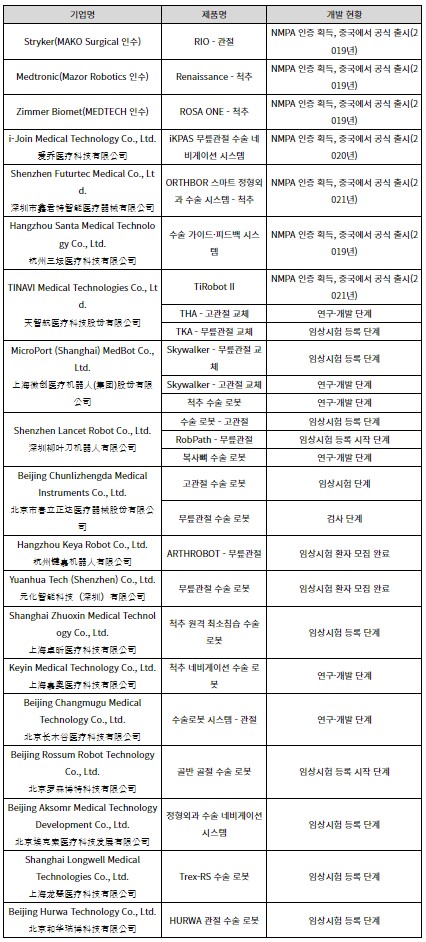
[Source: Healthcare Research Institute]
3) Interventional robot
The interventional robot inserts a catheter or a medical needle directly into a blood vessel or other body part and uses imaging medical devices such as angiography equipment, fluoroscopy equipment, ultrasound equipment, computed tomography (CT), and magnetic resonance imaging (MRI). It is a robot that treats while observing the inside of the body using In the case of cardiovascular and cerebrovascular surgery, a stent is installed minimally invasively by inserting a guide catheter into the groin or wrist artery. By injecting a contrast agent that does not penetrate X-rays, it can be transported to the target location in the blood vessel while seeing the blood vessels clearly. .
Currently, among local Chinese companies, MicroPort (微创机器人) and ABROBO (深圳爱博医疗) are spurring the development of interventional robots, but they are still in the research and development stage or clinical trial stage. There are no NMPA-approved products yet.
<Status of Development of Interventional Robots in China>
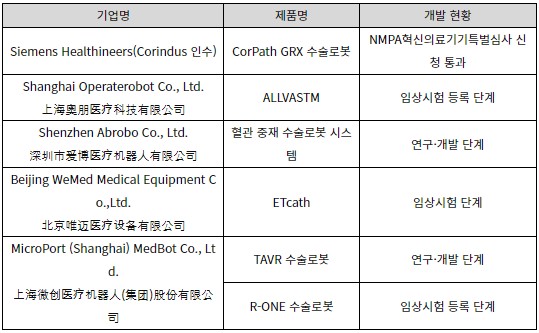
[Source: Healthcare Research Institute]
4) Other surgical robots
In addition, Broncus Medical (堃博医疗) and Lungcare (郎开医疗) bronchial endoscopic navigation equipment, and Perfint Healthcare (Perfint Healthcare) percutaneous surgical robot developed NMPA approval. and are actively entering the market.
<Status of development of other surgical robots in China>
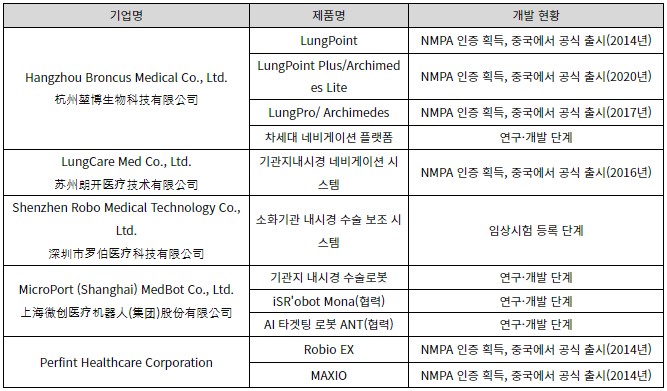
[Source: Healthcare Research Institute]
Active investment in the surgical robot industry
Meanwhile, investment in surgical robots in China is also actively being made. According to statistics, a total of 55 investments were made in the surgical robot industry last year, with the investment amounting to $100 billion, a 15% increase from the previous year.
<Status of Investment in the Surgical Robot Field in China>
(Unit: million dollars)
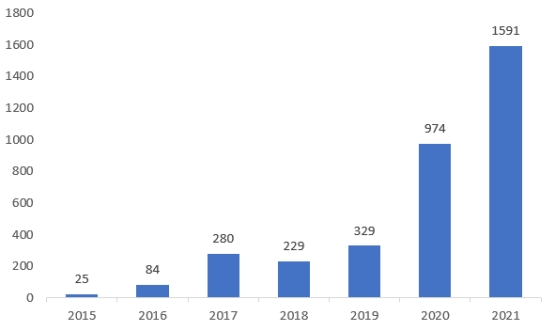
[Source: VBDATA(动脉橙)]
China's surgical robot market is still in its infancy
Robotic surgery in China is still in its infancy. According to industry statistics, at present, the use of robotic surgery for laparoscopic surgery and orthopedic surgery in China is only 0.51% and 0.03%, respectively. The penetration rate is very low compared to advanced countries such as the United States where the penetration rate of robotic surgery is high.
<Comparison of the Utilization Rate of Pediatric Robotic Surgery in China and the U.S.>
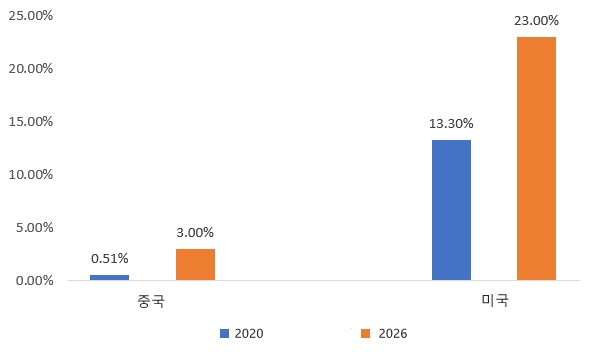
[Source: Frost & Sullivan]
<Comparison of use rate of orthopedic robotic surgery in China and the United States>
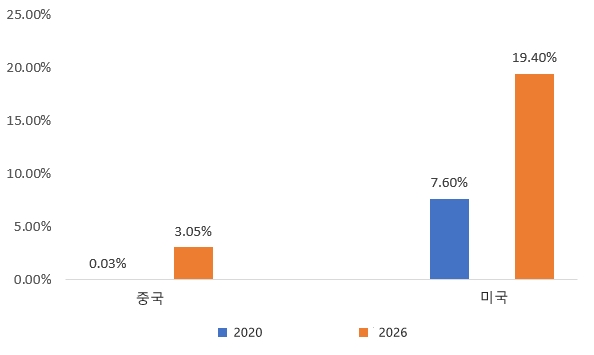
[Source: Frost & Sullivan]
This also means that the potential for future development is limitless if you think about it in reverse. Thanks to the improvement of national economic power, interest in advanced medicine is increasing in China, and the introduction of surgical robots in hospitals is expected to gradually increase. According to Frost & Sullivan, the number of surgical robot-applied surgeries in China is expected to increase exponentially from 2020 in 4 to 7,400 in 2026.
<Status and Prospects of Surgery Using Laparoscopic Robots in China>
(Unit: thousand cases)
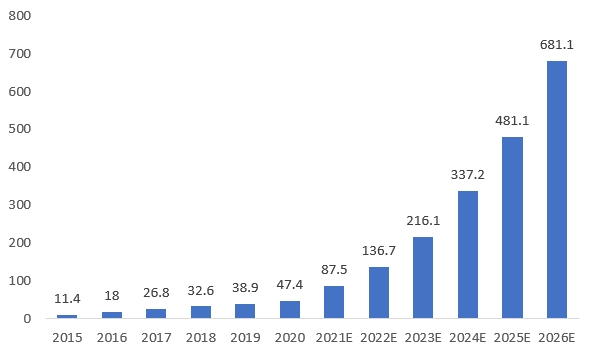
[Source: Frost & Sullivan]
<Status and Prospects of Orthopedic Surgery Using Robots in China>
(Unit: thousand cases)
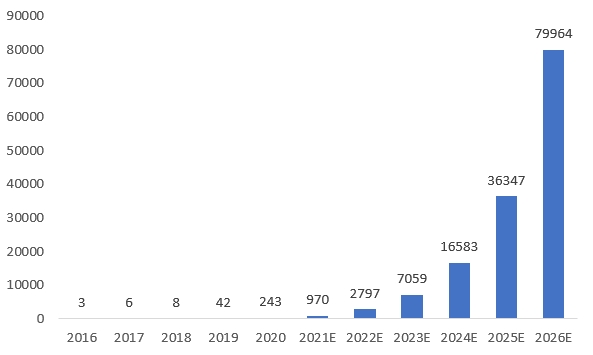
[Source: Frost & Sullivan]
implication
Surgical robots are high-tech intensive, high-value-added products, and the related market is currently entering the growth phase after the introduction phase. The size of the surgical robot market in China is also expected to grow at a CAGR of 2020% from 4 million dollars in 2,500 to about 44.3 billion dollars in 2026 as the use of surgical robots in hospitals gradually increases. Competition between foreign companies and local Chinese companies It seems to be getting hot.
On the other hand, as the Chinese government has focused on the localization of surgical robots, the threshold for foreign products to enter the market is quite high. Surgical robot-related certification and supervision standards are rather strict, and it usually takes more than two years for foreign companies to pass procedures including clinical trials. Recently, some foreign companies are accelerating their product entry into the Chinese market through cooperation with local Chinese companies. French company Robocath, Inc. signed a joint venture agreement with MicroPort (微创机器人) in November 2 with the goal of commercializing the 'R-One robotic surgery platform' in China. Intuitive Surgical, Inc., an American surgical robot manufacturer, also decided to establish a Da Vinci surgical robot manufacturing and R&D center in Shanghai last year in partnership with Fosun Pharma (复星医药) of China. An industry official said, “Global medical device companies are actively collaborating between companies to advance into the market in a timely manner. We have to look at cases.”
Sources: Frost & Sullivan, Kaiyuan Research (开源证券研究所), VBDATA (动脉橙), Healthcare Research Institute (健康界研究院), Shenyang Securities Co., Ltd. Comprehensive Data from KOTRA



